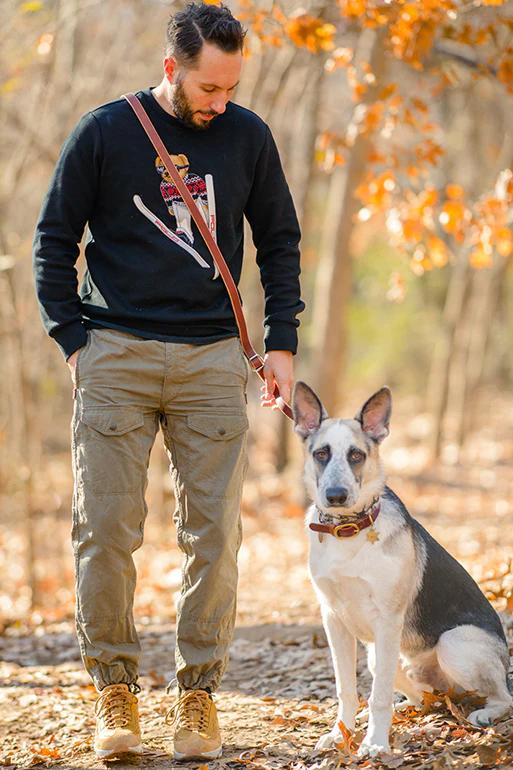Dog ownership is evolving—and so is the gear we use. For active owners who enjoy running, hiking, or even just multitasking while walking their pets, one piece of equipment stands out: the hands-free dog leash.
Designed to make outdoor adventures more convenient, hands-free dog leashes are becoming essential pet accessories for active lifestyles. This guide will explore how they work, their benefits, best use cases, and how to choose the right one for you and your dog.
What Are Hands-Free Dog Leashes?
Unlike traditional leashes that require you to hold one end, hands-free dog leashes are designed to wrap around your waist, shoulder, or torso, giving you full use of your hands while maintaining control over your dog.
These leashes often include:
- Adjustable waist or shoulder belts
- Shock-absorbing bungee cords
- Reflective stitching for visibility
- Multiple handles for added control
- Storage options (like pouches or loops for water bottles, keys, or treats)
This makes them ideal for active owners who want to combine their fitness routines with their dog’s daily walk.
Benefits of Hands-Free Dog Leashes
1. Improved Mobility and Convenience
When you don’t need to hold the leash, you can move more naturally—whether jogging, pushing a stroller, or using your phone. For runners and hikers, this freedom is a game-changer.
2. Better for Joint Health
Most hands-free dog leashes use shock-absorbing bungee cords that reduce strain on your arms, shoulders, and back. This can be especially helpful for people with joint issues or for dogs that tend to pull.
3. Enhanced Control
Many hands-free designs feature:
- Double handles for instant control in high-traffic areas
- Short leashes to keep dogs close while jogging
- Safety clips that prevent accidental unclipping
Some models are even designed to shift tension from the dog’s sudden pulls evenly across your body, which can offer more stability than a single-handed grip.
4. Encourages Active Lifestyles
By integrating your dog’s walk into your fitness routine, you’re more likely to stay active. Whether it’s trail running, hiking, or power walking, a hands-free leash makes your dog a reliable workout partner.
5. Keeps Hands Free for Gear or Kids
Parents, adventurers, and multitaskers can all benefit from keeping their hands free during walks. Carry groceries, manage a phone call, or take pictures of your dog—all without losing control.
Ideal Activities for Hands-Free Dog Leashes
Running and Jogging
The hands-free leash is a favorite among dog runners. With a waist belt, your stride stays balanced, and your arms swing freely.
Hiking
On the trails, you’ll want your hands for balance or climbing. A hands-free leash with a bungee section helps manage your dog on varied terrain.
Daily Walks
Even casual walks feel more comfortable when you’re not gripping a leash. Ideal for anyone who wants more flexibility.
Running Errands
Need to carry bags or use your phone? A hands-free leash makes it easier to manage your dog while shopping or commuting.
Choosing the Right Hands-Free Dog Leash
With so many options on the market, it’s important to choose the leash that matches your needs and your dog’s temperament.
Dog Size and Behavior
- Small to medium dogs: Standard bungee leashes work well.
- Large or strong pullers: Look for heavy-duty leashes with reinforced stitching and secure buckles.
- Reactive dogs: Choose a model with a close-control handle.
Activity Type
- For running, choose a lightweight leash with minimal bounce.
- For hiking, opt for a leash with gear loops and shock absorption.
- For urban walks, look for reflective stitching and easy-grip handles.
Safety Features
- Secure clips with lock mechanisms
- Padded waist belt with adjustable fit
- Reflective elements for night visibility
Additional Features
- Built-in storage for poop bags or treats
- Dual dog attachments for walking two pets
- Detachable leash options for flexibility
How to Use a Hands-Free Leash Safely
Using a hands-free dog leash offers freedom, but safety must still be your top priority.
Train Your Dog First
Before hitting the pavement hands-free, your dog should understand basic leash manners:
- Walk without pulling
- Respond to “heel,” “stop,” and “leave it”
- Stay focused in public areas
If your dog isn’t leash-trained, use a traditional leash for practice first.
Use in the Right Environment
Avoid hands-free leashes in:
- Crowded or high-traffic areas
- Near aggressive or reactive dogs
- With dogs that are easily distracted or not recall-trained
Pair With the Right Gear
A no-pull harness is ideal when using a hands-free leash, as it gives you better control and reduces strain on your dog’s neck. Avoid using choke collars or prong collars with hands-free systems.
Be Mindful of Surface and Weather
Running or walking on uneven surfaces, hot pavement, or icy paths can increase the risk of injury for you or your dog. Keep your route safe and leash length manageable.
Final Thoughts
For active owners, a hands-free dog leash is more than just a trend—it’s a practical solution that enhances the walking or running experience. Whether you’re training for a marathon or simply want more freedom on daily strolls, this innovative pet accessory can transform how you and your dog spend time together.
With the right leash, proper training, and attention to safety, you can enjoy hands-free walks that are fun, secure, and healthy for both you and your pet.


